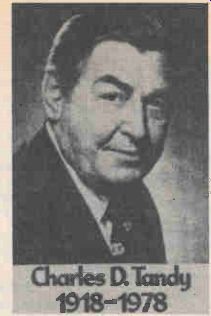
by Charles Graham
It's The Biggest (and One of the Best) Electronics Store in the World
In 1958 magazine publisher Milton Sleeper sent me to Boston to visit some high fidelity manufacturers. "And while you're there," he instructed me, "drop in to a store called Radio Shack. They've been putting out a mail catalog recently, and some of their stuff looks interesting."
I followed his instructions, and a few a days later I was talking to a young man named Bob Lewis, who was the manager of a retail store in downtown Boston, as well as their main engineer. He'd just finished designing one of the first FM (only) radio tuners and they called it "Realistic." A picture of this tuner, with its companion audio amplifier (both used vacuum tubes, of course) is shown here.
The amplifier had a 6SN7 voltage amplifier/phase inverter to drive the power amplifier tubes, a pair of 6V6s, with a full-wave rectifier completing the lineup. Note that there was no preamp tube for the phono pickup. This indicated that magnetic pickups weren't being used yet. The crystal pickups of the day had enough output ( 1 / 2 to 1.0 volt) to drive the amplifier directly.
You can also see that although the tuner had a metal cabinet, the amplifier was uncovered. In those early days of high fidelity it was not only unnecessary to hide the chassis, but the amplifier's tubes generated so much heat that a cabinet would have been difficult to ventilate adequately. The tuner's tubes generated much less heat, so it had a decorative metal cover.

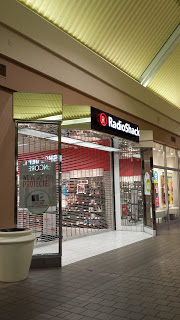
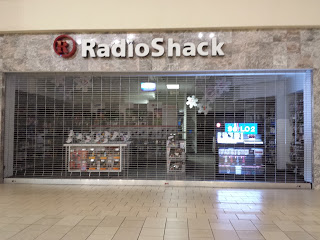
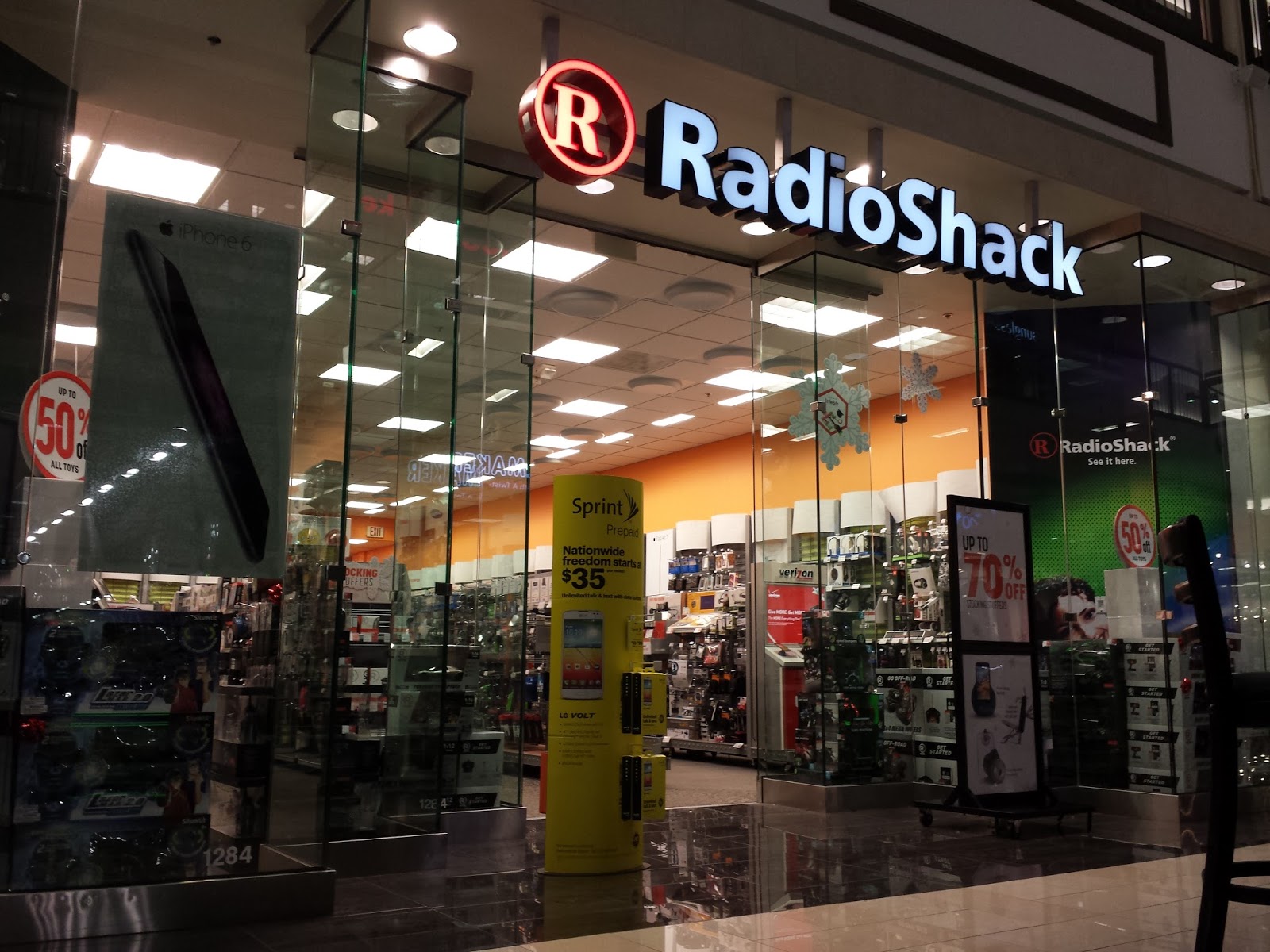
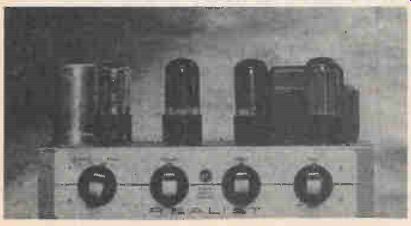

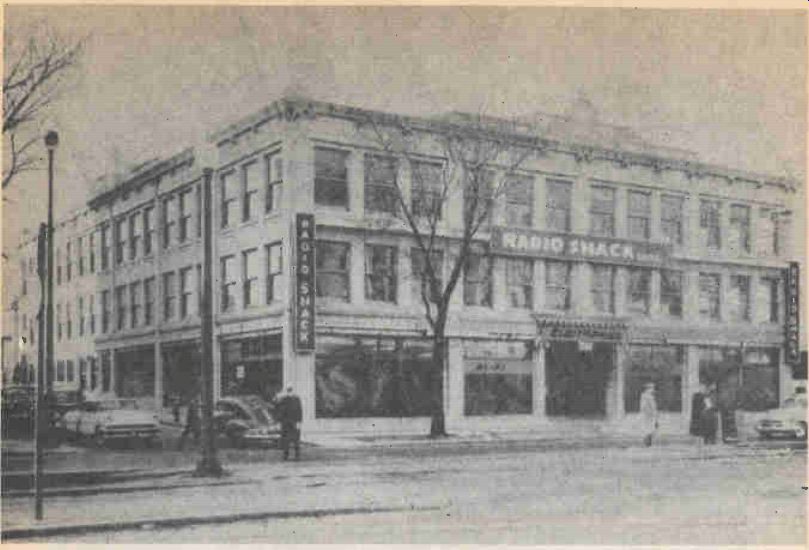
----------- This modest building (photographed in the late 1940s)
was in Boston. It housed the headquarters as well as the assembly,
receiving, shipping, etc. of Radio Shack's modest beginnings. It
also included one of their first stores. It contrasts sharply with
the nearly 8,000 stores the company has around the world today.
The store I visited was one of several in the Boston area, and its mail order catalog business was so successful after awhile that in the early Sixties a Texas-based firm, Tandy Leather Company, took over Radio Shack and moved . the headquarters to Dallas.
They began carrying radio and TV parts and kits for learning about electronics. They also produced low priced and medium-priced stereo components of excellent quality. Another reason for their success, and for buying Radio Shack stereo that I've often pointed out in print, is that their one-year (on some parts more) parts-and-labor guarantees are good at Radio Shack stores all over the country.
In 1977 Radio Shack began selling personal computers, the TRS-80 line, which early computer niks jocularly called "Trash-80." Meanwhile, Radio Shack was laughing all the way to the bank for it was the first manufacturer to sell personal computers.
After Apple came along Radio Shack continued to bring out new models, resisting the industry shift in the early Eighties to copying the IBM PC. They also had the lowest-cost computer for games, educational programs, and inexpensive introduction to computers, their Color Computers. First was the Model 1 in 1980, and then the Model 2. Recently the Model 3 Color Computer was brought out, and it continues to be the most-expandable and lowest-cost entry-level micro system.
In 1984 Tandy stopped fighting the trend to copy IBM's PC and joined the crowd, soon becoming the biggest seller of PC-compatible clones, with their Model 1000. The model 1000 successors and system components (monitors, printers, modems, software and accessories) are the lowest-priced similar equipment in the market. There are lower-priced PC clones sold by mail order. But you can't take them into your local store for help.
Tandy also spearheaded the portable computer market with its highly-successful lap-model 100 four years ago. This has been followed by successor model 102, 200, and now 600, while the earlier models continue to be sold and supported at ever-lower prices.
Watch For Sales
This is another advantage of shopping for computers (and other sizable items) at Radio Shack stores. They often run sales, and you can frequently save substantially on computers, radio, telephones etc. by watching for such sales.
Across the U.S. there are nearly 5,000 Radio Shack stores and over 2,500 Computer Centers. Many combine both at one location. This makes a total of 6,900 stores. There are also 166 Radio Shack Service Centers which serve these thousands of retail stores.
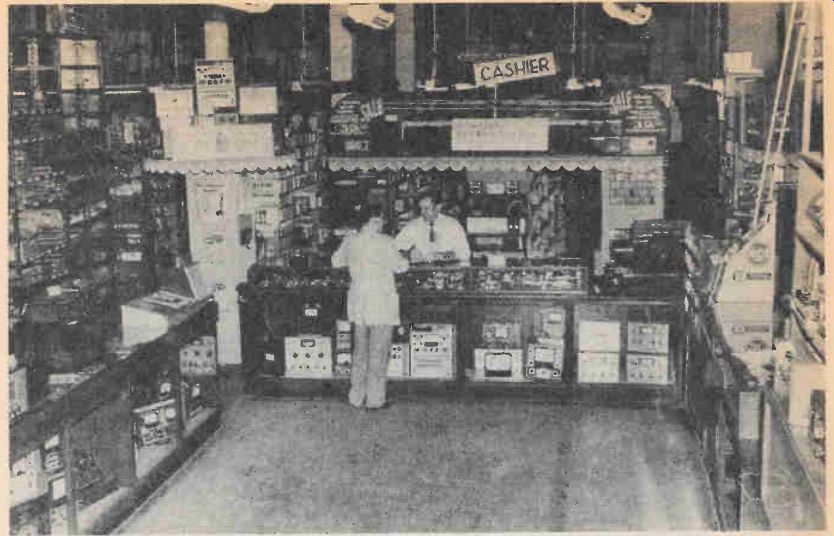
--------- Here's an early Radio Shack store on the inside. Like
many "parts" stores in those days (the Forties and Fifties)
it catered both to hobbyists and to service technicians, as evidenced
by the many test instruments (including Tube Testers) on display.
Like most early electronics supermarkets, it was so cluttered you
needed a sign to find the place to pay (Cashier).

Best Buy Microcomputers
Let's look at Tandy's line of PC clones (IBM compatibles) which, if you buy them during one of Tandy-Radio Shack's frequent computer sales, represents the Best Buys you can make in microcomputers today.
The highly-successful model 1000 micro has recently been replaced by two newer versions which offer new features. The new model 1000EX is the lowest priced MS-DOS personal computer, it is 50 percent faster than the original IBM PC. Targeted to the home and educational user, the 1000 EX has 256K RAM and uses the MS-DOS version 2.11 operating system, which is upgradable to version 3.2 at a reasonable price. Even with version 2.11 there are thousands of popular MS-DOS programs for the EX. It has one external 360K, 5 1 / 4-inch floppy disk drive, to which you can add a second 5 1 / 4-inch or a 3 1 / 2-inch 720K external drive. A three-voice circuit provides sound and music generation through a built-in speaker or headphone jack, and can use a "mouse" (like the Apple McIntosh, the Atari STS and the Commodore Amiga) as well as game joy-sticks. The 1000 EX package comes with Tandy DeskMate software, which is an electronic desktop, worksheet, and word processing program with a number of other applications, including telecommunications and electronic mail.
The 1000 SX packages two 360K drives internally, operates on MS-DOS version 3.2, and allows for expansion with its five PC-compatibles slots. This permits the addition of memory boards, and an internal modem or 20Mb hard disk card. It gives a little extra RAM as well, 384K, which is expandable to 640K on the main board. It too is 50 percent faster than the IBM PC, and makes use of the DeskMate.
Lap-Top Model 100
The most widely-sold lap-top (portable) has been Tandy's Model 100. It cost $1000 three years ago and has been on sale often, today it keeps selling at $400, but has been followed by later, improved models.
Improved Model 200
The Model 200 carries the same 24K memory, but has the popular MicroSoft MultiPlan spreadsheet software built into its permanent memory, and sports a forty-by-sixteen character liquid crystal graphics capable display. The permanent memory also holds an improved version of the Model 100's resident word processing software, along with several useful organizational and time management programs. It too allows programming in BASIC, but in addition features a parallel printer port, RS-232 interface, and cassette and bar code reader interfaces.
Model 600
The top-of-the-line Model 600 adds a built-in 3 1/2 inch, 360K disk drive to the portable package. The five time and organizational management software programs are there, along with the Microsoft MultiPlan spreadsheet, MicroSoft Word, word-processing, and MicroSoft File database programs.
The direct-connect modem operates at 300 bps. A bevy of options and accessories are available for all three models, including external disk drives, RAM upgrades, carrying cases, acoustic couplers, printer and modem cables, a bar code wand, and an ac adapter. The software, some of which requires a cassette recorder or ROM socket upgrade, ranges in price from $19.95 to $149.95
---------------------- Comparison of 1000SX & EX Model 1000SX
Microprocessor 8088
Operating system MS-DOS 32, GW BASIC
Model 1000EX 8088 MS-DOS 2 11, GW BASIC
Internal memory 384K, expandable 256K RAM to 640K expandable to 640K Internal expansion Disk drives Drive expansion 5 full-length IBM slots 2 double-sided, double-density Input/Output Parallel port, composite video, line level audio output, light pen port, 2 joysticks, Basic price $1200 $800 2 expansion boards 1 double sided.
double density external 360K 5 1 / 4 inch or 720K 31 / 2 inch drive Parallel port, composite video, 1/3-inch headphone jack with volume control, 2 joysticks
Also see:
More from EH magazine:
Adapted from: Electronics Handbook--Spring 1987